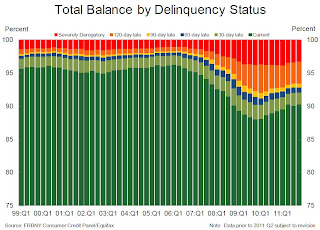by Calculated Risk on 2/27/2012 11:30:00 AM
Monday, February 27, 2012
NY Fed: Delinquent Debt Shrinks while Real Estate Debt Continues to Fall
From the NY Fed: Delinquent Debt Shrinks while Real Estate Debt Continues to Fall
Aggregate consumer debt fell $126 billion to $11.53 trillion in the fourth quarter of 2011 according to the Federal Reserve Bank of New York’s latest Quarterly Report on Household Debt and Credit, a 1.1 percent decrease from the $11.66 trillion reported in the prior quarter’s findings.Here is the Q4 report: Quarterly Report on Household Debt and Credit. Here are two graphs:
...
Mortgage and home equity lines of credit (HELOC) balances fell a combined $146 billion, a sign that consumers continue to reduce housing related debt.
After a mild uptick in the third quarter, total household delinquency rates resumed their downward trend in the fourth quarter. The report finds that $1.12 trillion of consumer debt (or 9.8 percent of outstanding debt) is currently delinquent, with $824 billion seriously delinquent (at least 90 days late). Meanwhile about 2.2 percent of mortgage balances transitioned into delinquency during the fourth quarter, resuming the recent trend of reductions in this measure. However, delinquency rates remain elevated compared to historical figures.
"While we continue to see improvements in the delinquent balances and delinquency transition rates this quarter, there has been a noticeable decrease in the rate of improvement compared to 2009-2010," said Andrew Haughwout, vice president and economist at the New York Fed. "Overall it appears that delinquency rates are stabilizing at levels that remain significantly higher than pre-crisis levels."
 Click on graph for larger image.
Click on graph for larger image.The first graph shows aggregate consumer debt decreased slightly in Q4. From the NY Fed:
Aggregate consumer debt fell slightly in the fourth quarter. As of December 31, 2011, total consumer indebtedness was $11.53 trillion, a reduction of $126 billion (1.1%) from its September 30, 2011 level. Mortgage balances shown on consumer credit reports fell again ($134 billion or 1.6%) during the quarter; home equity lines of credit (HELOC) balances fell by $12 billion (1.9%). Household mortgage and HELOC indebtedness are now 11.0% and 11.7%, respectively, below their peaks. Consumer indebtedness excluding mortgage and HELOC balances again rose slightly ($20 billion or about 0.8%) in the quarter. Consumers’ non-real estate indebtedness now stands at $2.635 trillion. Student loan indebtedness rose slightly, to $867 billion.
 The second graph shows the percent of debt in delinquency. In general, the percent of delinquent debt is declining, but what really stands out is the percent of debt 90+ days delinquent (Yellow, orange and red). The percent of seriously delinquent loans will probably decline quicker now that the mortgage servicer settlement has been reached.
The second graph shows the percent of debt in delinquency. In general, the percent of delinquent debt is declining, but what really stands out is the percent of debt 90+ days delinquent (Yellow, orange and red). The percent of seriously delinquent loans will probably decline quicker now that the mortgage servicer settlement has been reached. From the NY Fed:
As of December 31, 9.8% of outstanding debt was in some stage of delinquency, compared to 10.0% on September 30. About $1.12 trillion of consumer debt is currently delinquent, with $824 billion seriously delinquent (at least 90 days late or “severely derogatory”).There are a number of credit graphs at the NY Fed site.
...
About 2.2% of current mortgage balances transitioned into delinquency during 2011Q4, reinstating the recent trend of reductions in this measure which had been temporarily reversed in 2011Q3. The rate of transition from early (30-60 days) into serious (90 days or more) delinquency also fell slightly, to 28.8%. This reduction in delinquency transitions was accompanied by an improved cure rate: 27.2% of mortgage balances in early delinquency became “current” during the fourth quarter.


